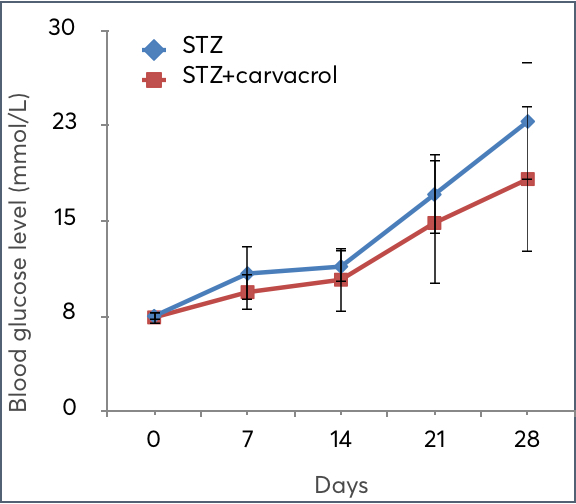Orally delivered carvacrol does not prevent type 1 diabetes development in C57BL/6 mice
Milica Vujicic, Tamara Saksida, Stanislava Stosic-Grujicic, Ivana Stojanovic
Department of Immunology, Institute for Biological Research “Sinisa Stankovic”, University of Belgrade
31 July 2018
Introduction
Type 1 diabetes (T1D) is an incurable inflammatory autoimmune disease that develops as a consequence of beta cell death provoked by the action of immune cells. It is a childhood disease in general, and its incidence is increasing on a yearly basis. Usually, T1D development scenario is the following: in a genetically susceptible individual immune cells infiltrate the pancreatic islets (insulitis) and induce beta cell apoptosis, insulin deficiency arises and hyperglycemia ensues (a major characteristic of T1D)(1). To date, versatile approaches have been tested for the treatment of T1D. Among these approaches, the usage of plant-derived products or plant extracts is becoming more and more popular due to the fact that many drugs actually originate from plants(1). Generally, plant products can have anti-oxidant, anti-inflammatory and anti-apoptotic features, all of them useful for the therapy of T1D. For example, methanolic and ethyl-acetate oregano extracts have been notably successful in preventing T1D that was induced by multiple low doses of streptozotocin in C57BL/6 mice (2)(3). The major constituents of these extracts rosmarinic and salvianolic acid were only partially responsible for the beneficial outcome of the whole extract application(2)(4). The third major constituent carvarol has not been investigated so far. Carvacrol (2-methyl-5-isopropylphenol) is a phenolic monoterpene present in essential oils produced in plants of the family Lamiaceae (for example oregano and thyme). Its anti-oxidant and anti-bacterial characteristics have been thoroughly investigated and historically used for the treatment of infections(5). Also, several studies have shown its beneficial role in type 2 diabetes related to: glucose-lowering effect(6)(7) improvement of cognitive effects in diabetic animals(8) and its cumulative effect with rosiglitazone in amelioration of high fat diet induced changes in lipids and inflammatory markers in C57BL/6J mice(9). Therefore, the aim of this study is to investigate whether carvacrol can be accountable for the already observed protective effects of oregano extracts.
Methodology
All experiments were approved by the Ethical Committee of the Institute for Biological Research “Sinisa Stankovic” and were in accordance with Directive 2010/63/EU. C57BL/6 mice were kept in the animal facility at the Institute for Biological Research “Sinisa Stankovic” under standard conditions with free access to standard pelleted diet and tap water.
T1D was induced in 2 months old male C57BL/6 mice by the intraperitoneal application of five consecutive doses of streptozotocin (40 mg/kg bw) (Sigma-Aldrich, St. Louis, MO, USA). Carvacrol (Sigma-Aldrich) was dissolved in olive oil (5 mg/ml) and applied orally (100 μl) for 10 days starting from the first dose of streptozotocin. Control animals received streptozotocin and olive oil in the same quantity. Groups consisted of 7 animals. Glucose was measured from the tail vein, once a week using a glucometer (Sensimac, IMACO GmbH, Lüdersdorf, Germany). Animals were considered hyperglycaemic if their blood glucose level was higher than 11 mmol/l (in non-fasted animals).
Result and discussion
The first signs of hyperglycemia in control (STZ) group developed approximately 7 days after the first streptozotocin injection (as expected). However, the oral application of carvacrol did not alter the blood glycemia levels throughout the examination period (28 days) (Fig. 1). These results suggest that carvacrol was unable to modulate the autoimmune attack that develops after the initial destruction of beta cells by streptozotocin. Streptozotocin operates through induction of reactive nitrogen and oxygen species. Since carvacrol can act as an anti-oxidant, these results suggest that it was also unable to oppose the effect of streptzotocin and prevent beta cell apoptosis. In addition, its established glucose-lowering effects (6)(7) were not operative in the curcumstances of severe beta cell destruction and absence of insulin as it was in the model of type 2 diabetes and insulin resistance (6)(7).
Figure
Figure 1. The effect of carvacrol on glycemia in C57BL/6 mice with T1D.

References
1. Chang CL, Chen YC, Chen HM, Yang NS, Yang WC. Natural cures for type 1 diabetes:
a
review
of phytochemicals, biological actions, and clinical potential. Curr Med Chem.
2013;20(7):899-907.
2. Vujicic M, Nikolic I, Kontogianni VG, Saksida T, Charisiadis P, Orescanin-Dusic
Z,
Blagojevic D, Stosic-Grujicic S, Tzakos AG, Stojanovic I. Methanolic extract of
Origanum
vulgare ameliorates type 1 diabetes through antioxidant, anti-inflammatory and
anti-apoptotic activity. Br J Nutr. 2015 Mar 14;113(5):770-82.
3. Vujicic M, Nikolic I, Kontogianni VG, Saksida T, Charisiadis P, Vasic B,
Stosic-Grujicic
S, Gerothanassis IP, Tzakos AG, Stojanovic I. Ethyl Acetate Extract of Origanum
vulgare
L.
ssp. hirtum Prevents Streptozotocin-Induced Diabetes in C57BL/6 Mice. J Food Sci.
2016
Jul;81(7):H1846-53.
4. Vujičić M, Saksida T, Sojanovic I. Salvianolic acid B: in vitro and in vivo
effects
on
the immune system. Arch Biol Sci 69(4) 2017.
5. Sharifi-Rad M, Varoni EM, Iriti M, Martorell M, Setzer WN, Del Mar Contreras M,
Salehi B,
Soltani-Nejad A, Rajabi S, Tajbakhsh M, Sharifi-Rad J. Carvacrol and human health: A
comprehensive review. Phytother Res. 2018
6. Ezhumalai M, Radhiga T, Pugalendi KV. Antihyperglycemic effect of carvacrol in
combination with rosiglitazone in high-fat diet-induced type 2 diabetic C57BL/6J
mice.Mol Cell Biochem. 2014 Jan;385(1-2):23-31.
7. Bayramoglu G, Senturk H, Bayramoglu A, Uyanoglu M, Colak S, Ozmen A, Kolankaya D.
Carvacrol partially reverses symptoms of diabetes in STZ-induced diabetic rats.
Cytotechnology. 2014 Mar;66(2):251-7.
8. Deng W, Lu H, Teng J. Carvacrol attenuates diabetes-associated cognitive deficits
in
rats. J Mol Neurosci. 2013 Nov;51(3):813-9.
9. Ezhumalai M, Ashokkumar N, Pugalendi KV. Combination of carvacrol and
rosiglitazone
ameliorates high fat diet induced changes in lipids and inflammatory markers in
C57BL/6J
mice. Biochimie. 2015 Mar;110:129-36.
Acknowledgements
This research was supported by the Ministry of Education, Science and Technological Development of the Republic of Serbia (grant No ON 173013).




